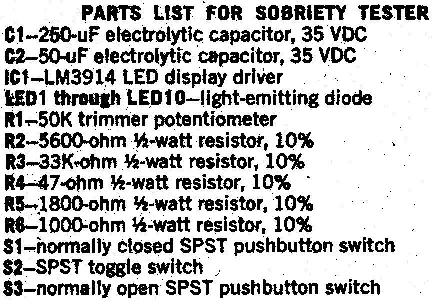
December 2001 Project : Sobriety Tester
With all the holidays upon us, understandably some of us will be drinking alcoholic beverages. This circuit can be used as a guideline how much you have had to drink and how good your reaction time is. This circuit does not tell you whether you are over the legal limit of alcohol in in your blood. This circuit can also be use for fun to test your reaction time. The circuit works as follows. Imagine for the moment that S1 switch is depressed which causes it to be open and S2 switch is closed. On command from someone acting as the tester, the person depressing S1 must remove his/her hand from the switch S1 and with the same hand toggle switch S2 to the open position.. When S1 is released, charging current begins to flow into capacitor C2 through R1 and R2. This current is interrupted, however, as soon as S2 has been opened. C2 will have accumulated a voltage directly proportional to the reaction time, which is the interval between S1's release and the opening of S2. Longer times create higher voltages and cause higher numbered LED's to light. For example, a sober person might react quickly enough to light LED 2 or LED , while someone truly sloshed will light up to LED 10. To run another test, discharge C2 with S3, then press S1 and, finally, close s2 once more. R1 should be adjusted so that a sober person lights one of the low numbered LED's. The supply voltage says 18 volts but 9, 12, or 15 will work fine also.

